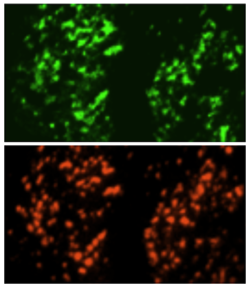LA JOLLA, CA—The ebb and flow of intracellular calcium concentrations is a universal mode of communication in mammalian cells. Among a wide variety of functions that impact nearly every aspect of cellular life, calcium signaling regulates the activity of T cells, which are an integral part of any effective immune response.
Publishing in the Proceedings of the National Academy of Sciences, researchers at the La Jolla Institute for Immunology (LJI) identified the matchmaker that brings two critical calcium channel components together, thus allowing calcium to rush into the fluid-filled space known as cytosol. In T cells, the calcium influx triggers tightly controlled gene expression programs that allow T cells to initiate a vigorous immune response and pull back when the work is done.
The findings of the LJI research team, led by Patrick Hogan, Ph.D., professor in the Division of Signaling and Gene Expression, provide a potential target for the development of drugs that modulate the activation status of T cells to fight infections and cancer more efficiently or to prevent inappropriate immune responses that underlie autoimmune diseases such as type 1 diabetes and rheumatoid arthritis.
“Depending on which signals are impinging at the same time, calcium signaling not only drives the effector response but also the tolerance response in T cells,” says Hogan. “Our hope is that we can learn to adjust the timing and strength of calcium signals, nudging the signal so that in this patient you get a bit more of the effector response and in that patient you get a bit more of the tolerance response, thereby pushing the patient’s T cells to reject tumor cells or fight viruses more effectively or bringing the T cells back from causing autoimmune disease.”
Calcium is stockpiled in intracellular depots located within the endoplasmic reticulum (ER), a network of tubules and membrane sheets that plays a central role in the synthesis of lipids and proteins. When calcium is released from this internal store, the resulting calcium signal is amplified by influx of calcium from outside the cell, and regulates a host of cellular functions such as immune responses, muscle contractions, nerve signals, cell growth and differentiation among many others.
The influx of calcium is triggered by the interaction of the regulatory molecule STIM1, located in the ER, and the calcium channel ORAI1, located in the plasma membrane. While it was clear that they can only interact at sites of close contact between the ER and the plasma membrane, so-called junctions, little was known about the molecules that organize the junctions for calcium signaling.

An earlier study by the LJI researchers had shown that septin scaffold proteins in the vicinity of junctions rearrange in response to ER calcium store depletion. This finding emphasized the importance of local membrane organization for calcium signaling, prompting LJI Instructor and first author Ariel Quintana and his colleagues to focus on transmembrane proteins identified in a genome-wide RNAi screen as potential regulators.
Their experiments revealed that ER membrane protein TMEM110, short for transmembrane protein 110, prepares the ground for STIM1 and ORAI1 to meet. It facilitates the relocation of STIM1 to ER–plasma membrane junctions and, acting in concert with other proteins, plays an integral role in the dynamic remodeling of the junctions during signaling.
The work was supported by the La Jolla Institute for Immunology, the Waitt Foundation, the W.M. Keck Foundation, the National Institutes of Health (CA014195, NS072031, AI084167, AI040127, GM110397, GM112003), the Deutsche Forschungsgemeinschaft, a Ruth L. Kirschstein-National Research Service Award and a China Scholarship Council Fellowship.
Full citation:
TMEM110 regulates the maintenance and remodeling of mammalian ER-plasma membrane junctions competent for STIM-ORAI signaling. Ariel Quintana, Vangipurapu Rajanikanth, Suzette Farber-Katz, Aparna Gudlur, Chen Zhang, Ji Jing, Yubin Zhou, Anjana Rao, and Patrick G. Hogan. PNAS, 2015.
DOI: www.pnas.org/cgi/doi/10.1073/pnas.1521924112
About La Jolla Institute for Immunology:
The La Jolla Institute for Immunology is dedicated to increasing knowledge and improving human health through studies of the immune system. Our essential purpose is to expand our understanding of how the immune system works and to discover the causes of immune system disorders. The knowledge gained through our biomedical research can, in turn lead to the prevention, treatment and cure of a wide range of human diseases.


